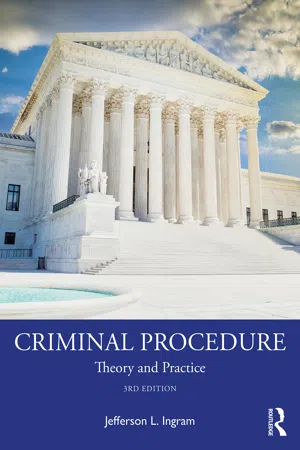
- 720 pages
- English
- ePUB (mobile friendly)
- Available on iOS & Android
About this book
Criminal Procedure: Theory and Practice, 3rd Edition, presents a broad overview of criminal procedure as well as a detailed analysis of specific areas of the law that require specialized consideration. The third edition provides students with an updated, comprehensive text written in reader-friendly language to introduce them to the field of criminal procedure.
Significant edited legal cases are integrated into each chapter, and comments, notes, and questions accompany each case. This edition features a new chapter covering searches of Internet-connected devices and electronic devices that may store personally connected data. The chapter "The Internet of Things" introduces search and seizure concepts related to electronics. In addition, a section at the conclusion of each chapter, "How Would You Decide," allows readers to examine the facts of a real case that contain some of the important concepts form each chapter. The reader can compare the individual's personal resolution of the case with the way the actual court determined the issue. Using a balanced text/case format, the author provides an overview of general criminal procedure as well as guidance for law enforcement actions that honor constitutional protections and comport with the rule of law. Instructor support material prepared by the author is available on our website, including lecture slides and instructor's manual with test bank, as well as online updates on new case law in the area of criminal procedure.
This textbook is ideal for all criminal justice programs in both four-year and two-year schools, especially those preparing future police officers, as well as a reference for law students and attorneys.
Frequently asked questions
- Essential is ideal for learners and professionals who enjoy exploring a wide range of subjects. Access the Essential Library with 800,000+ trusted titles and best-sellers across business, personal growth, and the humanities. Includes unlimited reading time and Standard Read Aloud voice.
- Complete: Perfect for advanced learners and researchers needing full, unrestricted access. Unlock 1.4M+ books across hundreds of subjects, including academic and specialized titles. The Complete Plan also includes advanced features like Premium Read Aloud and Research Assistant.
Please note we cannot support devices running on iOS 13 and Android 7 or earlier. Learn more about using the app.
Information
1 Introduction to the Constitutional and Legal Process
Learning Objectives
- Explain what the Framers of the three post-civil war amendments, the Thirteenth, Fourteenth, and Fifteenth Amendments, intended.
- Analyze the basic theory behind the selective incorporation doctrine that gradually incorporated some of the Bill of Rights into the due process clause of the Fourteenth Amendment.
- Identify the rights in the Bill of Rights that have been incorporated into the due process clause of the Fourteenth Amendment.
- Recognize and identify the more recent rights that have been selectively incorporated into the Fourteenth Amendment’s due process clause.
- Be able to explain why successive prosecutions by a state and the federal government are not considered double jeopardy.
- Explain the difference between an indictment and an information.
- Verbally trace the major trial process from jury selection to the verdict.
- Be able to explain the essential steps of the typical appellate process.
Chapter Outline
Part I Constitutional Introduction
- Constitutional Basis of Rights for Persons Accused of Crime
- Articles of Confederation
- The Constitution: Revision in National Government
- The Constitution: Challenges to Ratification
- Rationale and Need for the Bill of Rights
- History of the Bill of Rights
- Constitutional Developments: Civil War Era
- Selective Incorporation Doctrine: Federalization of Criminal Procedure
- Summary
Part II Overview of State and Federal Court Organization
- An Introduction to the Criminal Justice System
- Organization of Courts: State and Federal: A Dual System
Part III Pretrial and Trial Criminal Procedure: An Introduction
- The Initial Steps toward Prosecution: Pre-Trial Processes
- Pretrial Motions: Mandatory and Discretionary
- Jury and Non-Jury Trials
- The Trial Process From Selecting Jurors to Judgment
- Verdicts, Sentencing Process, and Post-Trial Motions
- Appellate Practice
- State and Federal Habeas Corpus
- Summary
KEY TERMS
- Articles of Confederation
- Bill of Rights
- Thirteenth Amendment
- Fourteenth Amendment
- Fifteenth Amendment
- Selective Incorporation
- Grand Jury Indictment
- Information
- Indictment
- Privilege Against Self-Incrimination
- Speedy Trial Right
- Habeas Corpus
- Jury Instructions
- Preliminary Hearing
- Pretrial Hearings
- Trial by Jury
PART I
Constitutional Introduction
1. Constitutional Basis of Rights for Persons Accused of Crime
2. Articles of Confederation
3. The Constitution: Revision in National Government
4. The Constitution: Challenges to Ratification
At the Massachusetts ratifying convention in early 1788, Federalists won assent for the new federal Constitution only by promising that they ...
Table of contents
- Cover
- Half Title
- Title
- Copyright
- Contents
- Preface
- 1 Introduction to the Constitutional and Legal Process
- 2 Basic Fourth Amendment Principles and the Exclusionary Rule
- 3 The Concept of Stop and Frisk
- 4 Arrest and Seizure of the Person
- 5 Miranda Principles: Fifth and Sixth Amendment Influences on Police Practice
- 6 Obtaining and Using Search Warrants: Practice, Execution, and Return
- 7 Searches and Seizures: Houses, Places, Persons, and Vehicles
- 8 The Internet of Things: Searches of Computers, Cell Phones, and Other Smart Devices
- 9 Searches of Open Fields and Abandoned Property
- 10 Special Needs Searches
- 11 Confession and the Privilege Against Self-Incrimination
- 12 Pretrial Criminal Process: Pretrial Motions, Identification Process, Preliminary Hearing, Bail, Right to Counsel, Speedy Trial, and Double Jeopardy
- 13 Trial Procedure and Legal Rights
- 14 Appellate Practice and Other Posttrial Remedies
- Appendix A: The Constitution of the United States
- Appendix B: The Bill of Rights and Other Amendments to the Constitution
- Glossary
- Index of Cases
- Subject Index